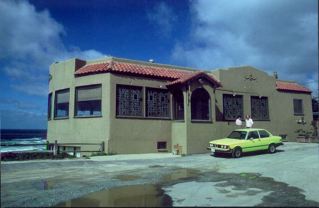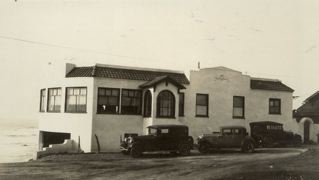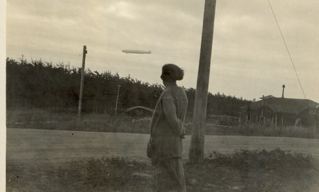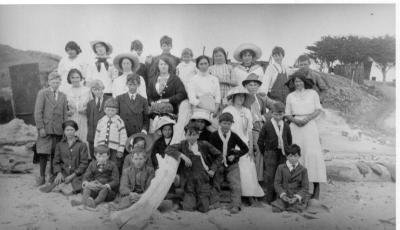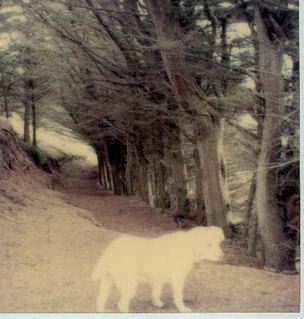
My Readers Stand On Rocks….
First Coastside School At Princeton & Sunshine Valley Road, Moss Beach
 Photo: Miss Rose Meehan with her students.
Photo: Miss Rose Meehan with her students.
From the archives of the San Mateo County History Museum [filed under Margaret Kyne] located in the Redwood City Courthouse.
“The location of the first schoolhouse was at Princeton where the Cosmopolitan building now stands, directly across from the John Patroni House. It was a two-room structure. The district ran from Pedro Point to Miramar. The teachers were Miss Kate McCarthy, principal, who was a sister-in-law of Mr. George Hall and Miss Rose Meehan, who for many yrs was vice prin of the grammar school at San Mateo near where the Junior College is now located, under George Hall. The school was moved in 1887 to Moss Beach, after a lengthy controversy over attendance and it was finally settled when [John] Kyne moved his family of seven children to Moss Beach. There was only one teacher, Mr. William Savage, who later became one of San Mateo Co’s proominent educators. After Mr. Savage, Rose Meehan returned to teach for a period of seven years. The school was located on the corner of Highway 1 and Etheldore Street, which is now the residence of Gregorio Rossi. In 1890 a new one-room schoolw as built in Sunshine Valley, which is now the home of Anthony Torre, and continued to be until 1910 when the present school was built. In those days attendeance was just as great as it is now with 45 to 50 in attendance….”
Signs Of A Different Kind On This Old Moss Beach Store
Can you see the reflection of the old Moss Beach schoolhouse in the windows? There’s an ad for “California Seeds”, Bass-Hueter paint, mixed and ready for use, and on sale at “here”–and two other signs, both of which say: “For Sale Below Cost”.
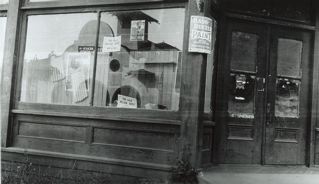
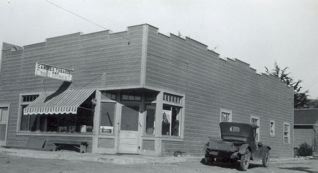 Photo: Is this the same building?
Photo: Is this the same building?
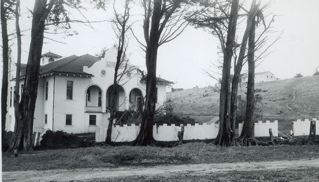 The Moss Beach Grammar School–the reflection seen in the windows of the building above.
The Moss Beach Grammar School–the reflection seen in the windows of the building above.
Custom-Made Table For The Famous Magician & His Artistic Wife
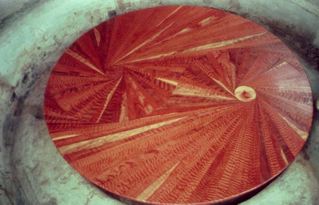
Photo: Table designed/built by John Morrall
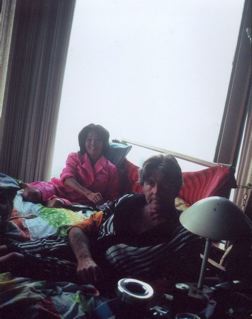 Photo: Corri & Channing.
Photo: Corri & Channing.
The magician Channing Pollock and his artist wife, Corri, had this beautiful, round table designed for their unusual Moss Beach house. The table was in their bedroom, with views of the Pacific Ocean, a place where they most often entertained their many friends. The table was set into a “pit” at floor level. The seating around the table was covered with the wall-to-wall rug.
What is it?
You can see it in the Pacific Ocean west of the Moss Beach Distillery–you can see it from the tidepools and the dreamy Cypress forest.
What is it?
It’s a concrete wall that dates back to WWII when it was erected to warn commercial fishermen and aircraft of the target practice range in the vicinity.
Blue Lady: The (In) Famous Moss Beach Ghost
In 1980 Dave Andrews (above, left), one of the owners of the Moss Beach Distillery, stood behind the bar of his restaurant overlooking the Fitzgerald Marine Reserve and told me about the roadhouse’s past. The interview with Andrews was for “The Mystery of Half Moon Bay”.
The Distillery was built in 1928 by Frank Torres, built originally, we think, as a residence, eventually a booming restaurant and bar.
There was a garage underneath that was used during Prohibition. Officials came from San Francisco and people who didn’t want to be seen in a bootleg restaurant. They would drive into the restaurant and then come up the back stairs.
We supposed it was used as a bordello. Of course, who knows what was going on.
This bay called Seal Cove was used quite actively during Prohibition. Boats from Canada would arrive outside and drop the booze off the side and float into the channel. There was a lookout on the hill to signal the boats. The signal warned whether there were any federal people here.
The Distillery was used as a hangout for a lot of movie stars, silent film stars that would come down from the City, such as Fatty Arbuckle. A lot of city officials from San Francisco would come down.
(David mentions that there were houses overlooking the ocean, houses that were part of the bordello and burned in the 1930s and 40s).
Story goes there was a triangle going on between the piano player and the jealous husband and so-called Lady in Blue was here in the evenings. Somehow a fight started between them. We think the murder [of the Lady in Blue] was a stabbing on the beach.
The Lady in Blue returned to the restaurant and she’s been here ever since, quite active late at night, moving chairs and walking around the place, slamming doors whenever she feels like she needs attention.
There’s a second story that the so-called “Blue Lady” was involved with silent film star Fatty Arbuckle.
I, myself, have heard her but never seen her.
Our maintenance man [who lives on the property] wakes up feeling somebody in the room, gets the feeling somebody’s always looking, staring at you and so when you wake up and there’s nobody there.
You hear noise and the chairs moving, tables moving and somebody in high heels walking across the floor.
I had people stay here that have heard the piano playing but there’s nobody here. And the piano’s been gone for several years.
One of our cocktail waitresses had her five-year-old daughter in the building. We were closing and the waitress and the bartender were talking to a couple of other people. The child came wandering in here, into the dining room and then she came running out screaming and saying, “There’s somebody in there. There’s a lady in blue.
Everybody walked back into the dining room and nobody was there. But the child obviously saw her.
Moss Beach Shrink Psychoanalyzes “The Coastsider” In 1980
In 1980 I interviewed Moss Beach psychiatrist Dr. Dorothy Zietz for “The Mystery of Half Moon Bay”. Her office was located in her home, a modern redwood house overlooking the sea.
Dr. Zietz arrived on the Coastside in 1959 and when I met her 20 years later, she said not much had changed.The Coastside was still relatively isolated, with many reminders of its rural past. The passage of Proposition 20 had limited development in the old Ocean Shore Railroad towns.
Most important, Dr. Zietz told me that the people hadn’t changed either. They were still “Coastsiders” as they once were.
“There’s no government here, no sense of community,” Dr. Zietz said. “No sense of neighborhood…Each small community is autonomous onto itself,” Dr. Zietz said, not complaining.
She added, again not complaining, that the “Board of Supervisors is not as aware of us as they might be. Things go on here that are not tolerated in Redwood City…We don’t want government interference, that’s what this country was based on….The old frrontierism is an attraction. On the Coastside there’s a chance to be free of things the urban person has to conform to…”
“Half Moon Bay and Pacifica are very different. Pacifica has a very identifiable government, their choice. We resist that in the true tradition of American spirit. We resist that. We don’t want a six-lane highway.”
“A highly socialized person could not exist here,” she told me. “There are no planned activities–that’s why we’re here…The person who chooses to stay does not need great contact with other people. There’s not much communication between people, nothing to join– yet there’s joining.”
In Dr. Zietz’s opinion, a society showed true maturity when the people could live without structure.



